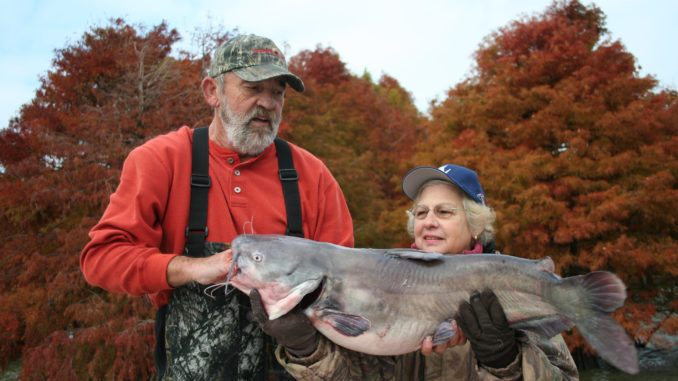
Meetings being held around lakes to discuss possible solution to problem
The blue catfish population, which has supported a tremendous recreational and commercial fishery in the Santee Cooper lakes for almost 50 years, is in serious decline, and biologists think a near-decade long drought may be the cause.
“We have seen a pretty dramatic decline in the numbers of smaller blue catfish,” said Ross Self, chief of freshwater fisheries for the S.C. Department of Natural Resources, who cited record low water levels as the probable culprit.
Reproduction may have been good in the past decade, but there was not enough for the smaller fish to eat, so recruitment was diminished. As recruitment lagged, fishing continued at normal levels, so the population was hit with a double whammy; fewer fish coming into the system as more were being taken out than the population could sustain.
The last strong year for blue catfish recruitment was 2003, which also was the last big-water year in the lakes until the record rainfalls this summer, according to Scott Lamprecht, regional fisheries biologist for the lakes.
“Those 2003 fish have made up 40 to 50 percent of our population sampling the last three or four years,” Lamprecht said. “We’ve been patiently waiting for those numbers to change, thinking the environmental conditions would improve, but we have not seen any increase.”
Lamprecht said biologists are very optimistic about conditions in the lakes this year because all the rain brought lake levels back up.
“However, in the meantime, we have fished our population down to levels we have not seen since the 1970s when the population was expanding,” he said. “It’s pretty obvious that in order to aid recovery of the blue catfish population we would need to cut the harvest drastically.”
How to best reduce the harvest and minimize the effect on the several user groups that depend on the blue catfish fishery is being explored during a series of public meetings around the lakes with fishing guides, commercial fishermen, recreational fishermen and fish camps.
Self said there are few options to reduce harvest – setting a daily limit, reducing the size limit of the one fish over three feet allowed per day (from 36 inches down to 34 or 32 inches), closing the season for part of the year, closing some areas of the lakes to commercial devices and limiting entry into the commercial fishery.
“We are not proposing specifics on any restrictions right now,” Lamprecht said. “We are trying to show everybody involved that something has to be done to bring the population back. We can’t continue doing the same thing we have been doing and expect the population to recover, so we have to cut the harvest drastically.”
After the public meetings, Lamprecht and the SCDNR’s fisheries staff will use that input in designing new regulations to curb the blue catfish harvest and provide better opportunity for recruitment, Self said.
Lamprecht said that although the blue catfish is not a native species, nor a gamefish, it must be managed because it is of such great importance economically to the region around the lakes. Based on studies done 10 years ago, fishing for the species accounted for almost 50 percent of the money spent on fishing at the lakes.
“It outdid largemouth bass, crappie and stripers at that time,” he said.
There is one bright side to the situation, Lamprecht noted. Blue catfish grow quickly under good conditions.
“Our density is greatly reduced, so you can expect the fish that are protected to grow at maximum growth rates and that is significant.”
Records show fish produced during low densities reached 50 pounds in 10 years, he said.
“These low densities can potentially have some good effects, but as far as everybody’s enjoyment, these densities are not acceptable,” he said. “We don’t want to go back to where we were in the ’90s when the population was so dense that growth was impaired.”
In the ’90s, he explained, the blue catfish population was so dense it was eating up the food base.




Be the first to comment